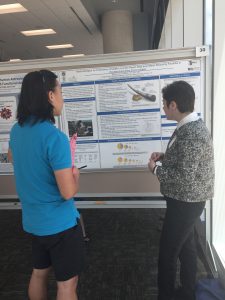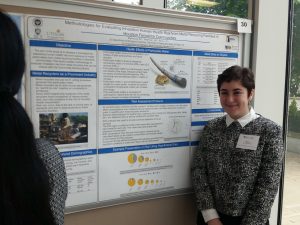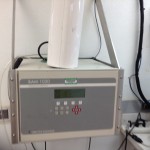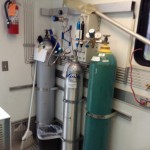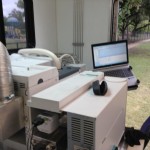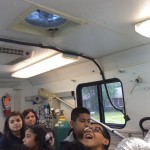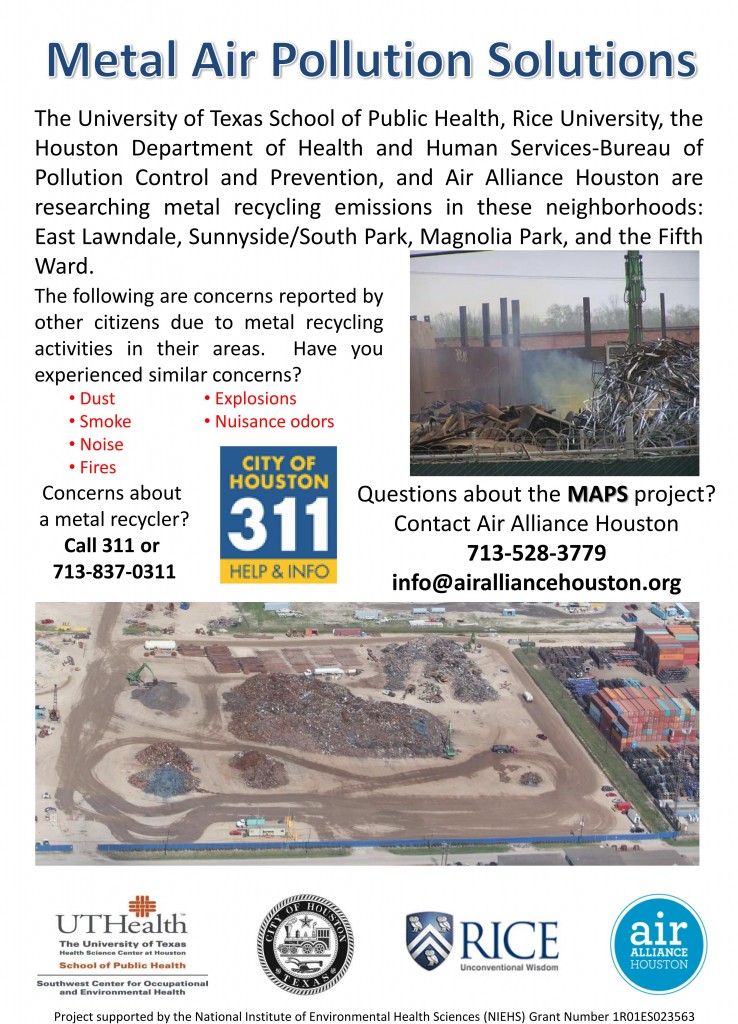Below is our past and current research.
Summary of health statements from the most recent studies.
- The increased risk of an asthma attack is 10% for single-day and 13% for three-day-long exposures when the ozone levels are between 50 to 70 ppb. If we move to higher levels of zone in the range of 70 to 90 ppb, the risks increase to 21% for one day and 45% if exposed for three days (Details on findings can be found here).
- For heart patients, the concern is a three-hour window of elevated ozone levels. A 20 ppb increase in ozone levels resulted in a 4% increase in risk of cardiac arrest associated with ozone. The impact is greatest when the ozone levels are above 75 ppb. (Details on findings can be found here).
Metal Recyclers in Houston, TX
The objective of this project was to conduct a risk assessment from air samples taken near a metal recycler. Our summer intern Sara Mahmoud worked on this project for Summer of 2017. Below are pictures of her presentation. Great work Sara!
Lead in Children
The objective of this project was to understand blood lead poisoning exposure sources among children in Houston and identify high risk areas by zip code using a unique
database collected from lead inspection reports from the city of Houston that no one previously had access to. Our summer intern Miguel Fraga worked on this project for Summer of 2016. Below are pictures of his presentation. He was a winner for best poster out of the 55 entries! Good work Miguel.
Bridge to Clean Air

Ambient Air Awareness Outreach to HISD students!
- Photographs curtesy of Jerlyn Williams
- Photographs curtesy of Jerlyn Williams
- Photographs curtesy of Jerlyn Williams
- Photographs curtesy of Jerlyn Williams
- Photographs curtesy of Jerlyn Williams
- Photographs curtesy of Jerlyn Williams
Asthma and Air Pollutants
Alert Houston Children with Asthma about Air Danger
Out-Of-Hospital-Cardiac-Arrest and Air Particulates
The association between OHCA and air pollution concentrations hours and days before onset was assessed using time-stratified case-crossover design using 11,677 EMS logged OHCA events between 2004-2011 in Houston, Texas. Air pollution concentrations were obtained from an extensive area monitor network. The findings confirm the link between OHCA and PM2.5 and introduce evidence of a similar link with ozone.
Articles related to this research were published by Circulation and The James A. Baker III Institute for Public Policy and can be found here (Circulation) and here (Baker Report).
Out-Of-Hospital-Cardiac-Arrest Geographic Corridors
Rates of OHCA and B-CPR varied within the city. We identified the geographic corridors of high OHCA rate and low B-CPR rate using multivariable count regression analyses.
The article related to this research was published in the American Journal of Preventive Medicine and can be found here.
Summary
Our studies use the 911 calls to the City of Houston for health outcomes. The health data begins in 2004 and end with the most recent data at the time of the analysis. We utilize the extensive monitoring network in Houston for air quality data and census tract data for community specific demographics. Statistical methodologies focus on the case-crossover study design coupled with conditional logistic regression, where we condition the analysis by subject.
Other research projects
Polychlorinated Biphenyl (PCB) Fingerprinting Analysis
Fingerprint the PCBs in the sediment – Analyzed the sediment PCB congener concentration data at each station and determine if the stations act differently or the same as each other (individually or grouped) in terms of the sediment PCB profiles. Sediment PCB fingerprints provides information useful in identifying a remedy, evaluating toxicity, and persistence and also provides an indication of different source types or ages of PCBs found in the sediment when the percent composition of PCBs varies spatially.
Associate PCBs in sediment to PCBs in fish – Identify the relationship between PCB congeners in the sediment with PCBs in the fish. An association between PCBs in sediment and PCBs in fish can be used to provide an estimate of the concentration in the sediment required to lower the concentration in the fish to a given level. This relationship may be better defined given the PCB sediment fingerprint.
Metal Recycling Businesses and Cancer Risk
Initiating with community complaints of nuisance from smoke, dust and odor, the Houston Department of Health and Human Services began a monitoring program outside metal recycler facilities and found metal particulates in outdoor ambient air at levels which could pose a carcinogenic human health risk. In a study of five similar metal recycler facilities which used a torch cutting process, air downwind and outside the facility was sampled for eight hours between 6 and 10 times each over 18 months using a mobile laboratory.
The published article related to this research can be found here.
Funding Announcement for a Sustainable Solution to Metal Air Pollution in Disadvantages Neighborhoods
Metal Recycler Air Pollution Project Team Leaders

Loren Hopkins, Rice University; Elaine Symanski (PI), UTSPH; Adrian Shelly, Air Alliance Houston; and Daisy James, City of Houston Health Department
Last updated 01/13/2020 If you find a broken link, please e-mail lac3@rice.edu. Thank you.



